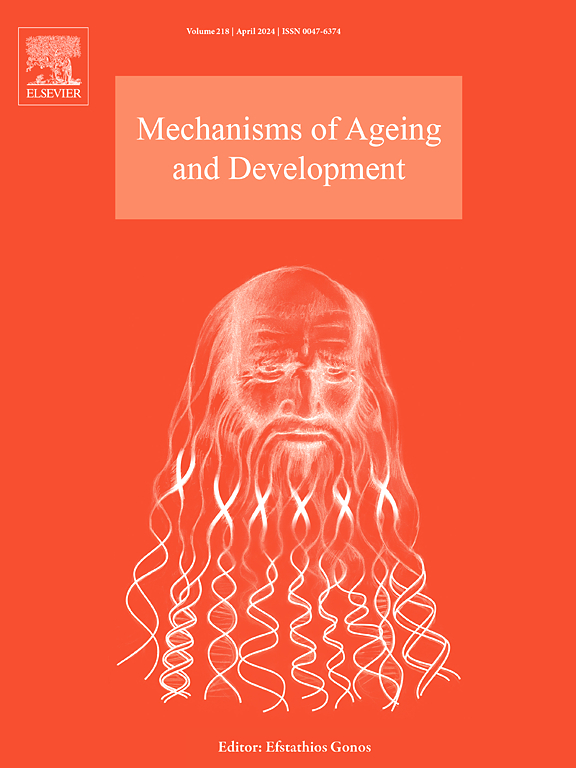Sirtuin 3 drives sex-specific responses to age-related changes in mouse embryonic fibroblasts
IF 5.1
3区 医学
Q2 CELL BIOLOGY
引用次数: 0
Abstract
The aging process is a complex phenomenon characterised by a gradual decline in physiological functions and an increased susceptibility to age-related diseases. An important factor in aging is mitochondrial dysfunction, which leads to an accumulation of cellular damage over time. Mitochondrial Sirtuin 3 (Sirt3), an important regulator of energy metabolism, plays a central role in maintaining mitochondrial function. Loss of Sirt3 can lead to reduced energy levels and an impaired ability to repair cellular damage, a hallmark of the aging process. In this study we investigated the impact of Sirt3 loss on mitochondrial function, metabolic responses and cellular aging processes in male and female mouse embryonic fibroblasts (MEF) exposed to etoposide-induced DNA damage, which is commonly associated with cellular dysfunction and senescence. We found that Sirt3 contributes to the sex-specific metabolic response to etoposide treatment. While male MEF exhibited minimal damage suggesting potential prior adaptation to stress due to Sirt3 loss, female MEF lacking Sirt3 experienced higher vulnerability to genotoxic stress, implying a pivotal role of Sirt3 in their resistance to such challenges. These findings offer potential insights into therapeutic strategies targeting Sirt3- and sex-specific signalling pathways in diseases associated with DNA damage that play a critical role in the aging process.
Sirtuin 3 驱动小鼠胚胎成纤维细胞对年龄相关变化做出性别特异性反应
衰老过程是一个复杂的现象,其特点是生理功能逐渐衰退,对老年相关疾病的易感性增加。衰老的一个重要因素是线粒体功能障碍,它会随着时间的推移导致细胞损伤累积。线粒体 Sirtuin 3(Sirt3)是能量代谢的重要调节因子,在维持线粒体功能方面发挥着核心作用。Sirt3 的缺失会导致能量水平降低,修复细胞损伤的能力受损,这是衰老过程的一个标志。在这项研究中,我们研究了 Sirt3 缺失对暴露于依托泊苷诱导的 DNA 损伤(通常与细胞功能障碍和衰老有关)的雄性和雌性小鼠胚胎成纤维细胞(MEF)的线粒体功能、代谢反应和细胞衰老过程的影响。我们发现 Sirt3 对依托泊苷处理的性别特异性代谢反应做出了贡献。雄性MEF表现出最小的损伤,这表明由于Sirt3的缺失,雄性MEF可能事先适应了压力,而缺乏Sirt3的雌性MEF更容易受到基因毒性压力的影响,这意味着Sirt3在雌性MEF抵抗此类挑战的过程中起着关键作用。这些发现为针对Sirt3和性别特异性信号通路的治疗策略提供了潜在的启示,这些通路可用于治疗与DNA损伤相关的疾病,而DNA损伤在衰老过程中起着至关重要的作用。
本文章由计算机程序翻译,如有差异,请以英文原文为准。
求助全文
约1分钟内获得全文
求助全文
来源期刊
CiteScore
11.10
自引率
1.90%
发文量
79
审稿时长
32 days
期刊介绍:
Mechanisms of Ageing and Development is a multidisciplinary journal aimed at revealing the molecular, biochemical and biological mechanisms that underlie the processes of aging and development in various species as well as of age-associated diseases. Emphasis is placed on investigations that delineate the contribution of macromolecular damage and cytotoxicity, genetic programs, epigenetics and genetic instability, mitochondrial function, alterations of metabolism and innovative anti-aging approaches. For all of the mentioned studies it is necessary to address the underlying mechanisms.
Mechanisms of Ageing and Development publishes original research, review and mini-review articles. The journal also publishes Special Issues that focus on emerging research areas. Special issues may include all types of articles following peered review. Proposals should be sent directly to the Editor-in-Chief.

 求助内容:
求助内容: 应助结果提醒方式:
应助结果提醒方式:


